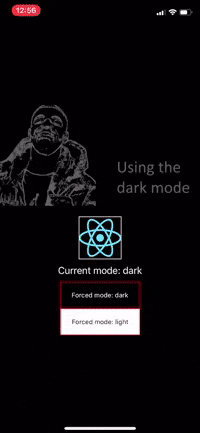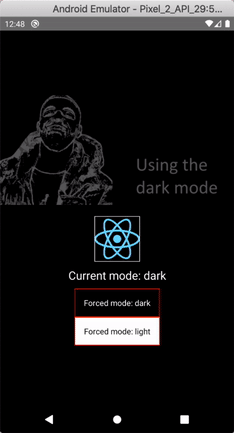You must append |uiMode to the android:configChanges prop of <activity> in AndroidManifest.xml. Example:
diff --git a/android/app/src/main/AndroidManifest.xml b/android/app/src/main/AndroidManifest.xml
--- a/android/app/src/main/AndroidManifest.xml
+++ b/android/app/src/main/AndroidManifest.xml
@@ -13,7 +13,7 @@
<activity
android:name=".MainActivity"
android:label="@string/app_name"
- android:configChanges="keyboard|keyboardHidden|orientation|screenSize"
+ android:configChanges="keyboard|keyboardHidden|orientation|screenSize|uiMode"
android:windowSoftInputMode="adjustResize">
<intent-filter>
<action android:name="android.intent.action.MAIN" />npm install react-native-dark-mode
cd ios && pod install # for iOSnpm install react-native-dark-mode
react-native link react-native-dark-modeReturns a boolean. true when dark mode is on.
import { useDarkMode } from 'react-native-dark-mode'
function Component() {
const isDarkMode = useDarkMode()
return <View style={{ backgroundColor: isDarkMode ? 'black' : 'white' }} />
}Returns dark or light.
import { useDarkModeContext } from 'react-native-dark-mode'
const backgroundColors = {
light: 'white',
dark: 'black',
}
function Component() {
const mode = useDarkModeContext()
const backgroundColor = backgroundColors[mode]
return <View style={{ backgroundColor }} />
}Just like StyleSheet but with support for dynamic values.
import { DynamicStyleSheet, DynamicValue, useDynamicStyleSheet } from 'react-native-dark-mode'
const dynamicStyles = new DynamicStyleSheet({
container: {
backgroundColor: new DynamicValue('white', 'black'),
flex: 1,
},
text: {
color: new DynamicValue('black', 'white'),
textAlign: 'center',
},
})
function Component() {
const styles = useDynamicStyleSheet(dynamicStyles)
return (
<View style={styles.container}>
<Text style={styles.text}>My text</Text>
</View>
)
}Allows you to set a specific mode for children.
import { DarkModeProvider } from 'react-native-dark-mode'
function MyScreen() {
return (
<>
{/* will be rendered using dark theme */}
<DarkModeProvider mode="dark">
<Component />
</DarkModeProvider>
{/* will be rendered using light theme */}
<DarkModeProvider mode="light">
<Component />
</DarkModeProvider>
{/* will be rendered using current theme */}
<Component />
</>
)
}It is recommended to wrap your application in a DarkModeProvider without a mode prop to observe a performance improvement.
function App() {
return (
<DarkModeProvider>
{/* ... */}
</DarkModeProvider>
)
}Returns the appropriate value depending on the theme. You can either pass a DynamicValue or just two arguments.
import { DynamicValue, useDynamicValue } from 'react-native-dark-mode'
const lightLogo = require('./light.png')
const darkLogo = require('./dark.png')
const logoUri = new DynamicValue(lightLogo, darkLogo)
function Logo() {
const source = useDynamicValue(logoUri)
return <Image source={source} />
}import { useDynamicValue } from 'react-native-dark-mode'
function Input() {
const placeholderColor = useDynamicValue('black', 'white')
return <TextInput placeholderTextColor={placeholderColor} />
}This is the initial mode that the app started in.
import { initialMode } from 'react-native-dark-mode'
console.log('App started in', initialMode, 'mode')Allows you to subscribe to changes in the mode.
import { eventEmitter } from 'react-native-dark-mode'
eventEmitter.on('currentModeChanged', newMode => {
console.log('Switched to', newMode, 'mode')
})- Xcode 11
- React Native 0.59.9 or higher
- iOS 13 to see it in action
- Android 10 or Android Auto to see it in action



